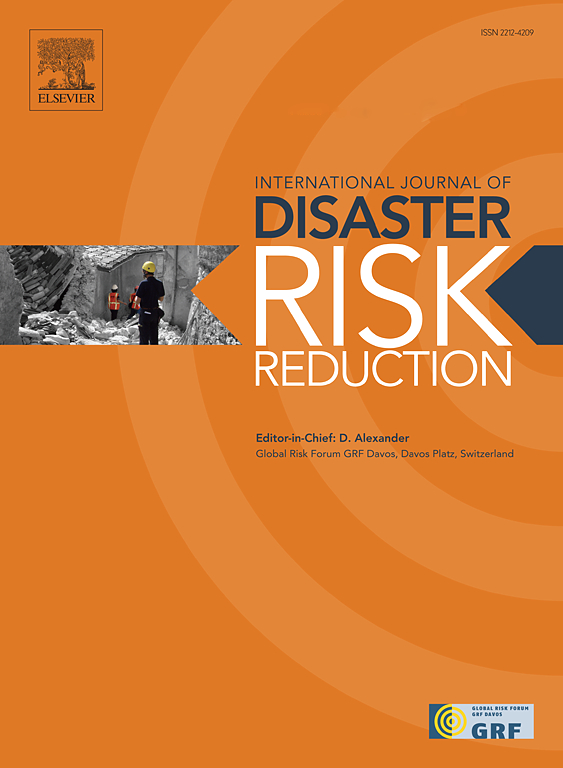共同设计即参与:在 Ohkay Owingeh Pueblo 创造有意义的洪水风险适应合作途径
IF 4.2
1区 地球科学
Q1 GEOSCIENCES, MULTIDISCIPLINARY
International journal of disaster risk reduction
Pub Date : 2024-09-21
DOI:10.1016/j.ijdrr.2024.104843
引用次数: 0
摘要
考虑到野火在新墨西哥州造成的有害影响,迫切需要制定创新的灾害适应和缓解战略。以社区为基础的灾害应对方法有可能利用共同设计和传统知识的力量,帮助大大减少传统研究和设计过程中的榨取。在本文中,我们将探讨以社区为基础、自下而上的方法与自上而下的集中式方法相比,哪些因素可以支持成功的结果。通过对 "自下而上 "的项目比 "自上而下 "的项目更有效这一观点的批判,我们旨在修正一个常见的参与式设计框架--双钻设计法,并提出一个社区参与的洪水风险适应框架,通过共同设计一个环境数据仪表盘来弥补这一不足。通过采用更加以人为本的设计方法作为基线,并以社区为中心进行进一步修正,可以缓解这一问题。我们在新墨西哥州的 Ohkay Owingeh Pueblo 举办了一系列研讨会,以整合当地知识。这些研讨会的目标是设计一个环境数据仪表盘,最终作为普韦布洛的信息收集和传播点。研讨会的特色活动是使共同设计过程非殖民化,并将普韦布洛的需求置于仪表板设计过程的中心。研讨会允许以各种方式参与--视觉的、口头的、听觉的--为社区成员提供了领导和以多种不同形式参与的空间。本文章由计算机程序翻译,如有差异,请以英文原文为准。
Co-design as participation: Creating meaningful pathways for collaboration in flood risk adaptation in Ohkay Owingeh Pueblo
Considering the detrimental effects caused by wildfires in New Mexico, there is a pressing need for the development of innovative hazard adaptation and mitigation strategies. Community-based approaches in hazard response have the potential to harness the power of co-design and the incorporation of traditional knowledge to help make conventional research and design process considerably less extractive. In this paper, we explore the elements of community based, bottom-up approaches that can support successful outcomes, in contrast to centralized top-down approaches. By offering a critical perspective of the idea that projects defined as bottom-up are inherently more effective than those that are top-down, we aim to amend a common participatory design framework, the double-diamond design method, and present a community-engaged framework on flood risk adaptation with the co-design of an environmental data dashboard to address this gap. This can be mitigated by employing a more human-centered design approach as a baseline, and further amending it to center community. We employed a series of workshops in Ohkay Owingeh Pueblo, in New Mexico, to integrate local knowledge. The goal of these workshops was to design an environmental data dashboard that would eventually serve as a point of information gathering and dissemination for the Pueblo. The workshops featured activities that worked to decolonize the process of co-design and put the Pueblo's needs at the center of the dashboard design process. The workshops allowed for participation in a variety of modalities – visual, verbal, auditory – giving community members space to lead and participate in many different formats.
求助全文
通过发布文献求助,成功后即可免费获取论文全文。
去求助
来源期刊

International journal of disaster risk reduction
GEOSCIENCES, MULTIDISCIPLINARYMETEOROLOGY-METEOROLOGY & ATMOSPHERIC SCIENCES
CiteScore
8.70
自引率
18.00%
发文量
688
审稿时长
79 days
期刊介绍:
The International Journal of Disaster Risk Reduction (IJDRR) is the journal for researchers, policymakers and practitioners across diverse disciplines: earth sciences and their implications; environmental sciences; engineering; urban studies; geography; and the social sciences. IJDRR publishes fundamental and applied research, critical reviews, policy papers and case studies with a particular focus on multi-disciplinary research that aims to reduce the impact of natural, technological, social and intentional disasters. IJDRR stimulates exchange of ideas and knowledge transfer on disaster research, mitigation, adaptation, prevention and risk reduction at all geographical scales: local, national and international.
Key topics:-
-multifaceted disaster and cascading disasters
-the development of disaster risk reduction strategies and techniques
-discussion and development of effective warning and educational systems for risk management at all levels
-disasters associated with climate change
-vulnerability analysis and vulnerability trends
-emerging risks
-resilience against disasters.
The journal particularly encourages papers that approach risk from a multi-disciplinary perspective.
 求助内容:
求助内容: 应助结果提醒方式:
应助结果提醒方式:


